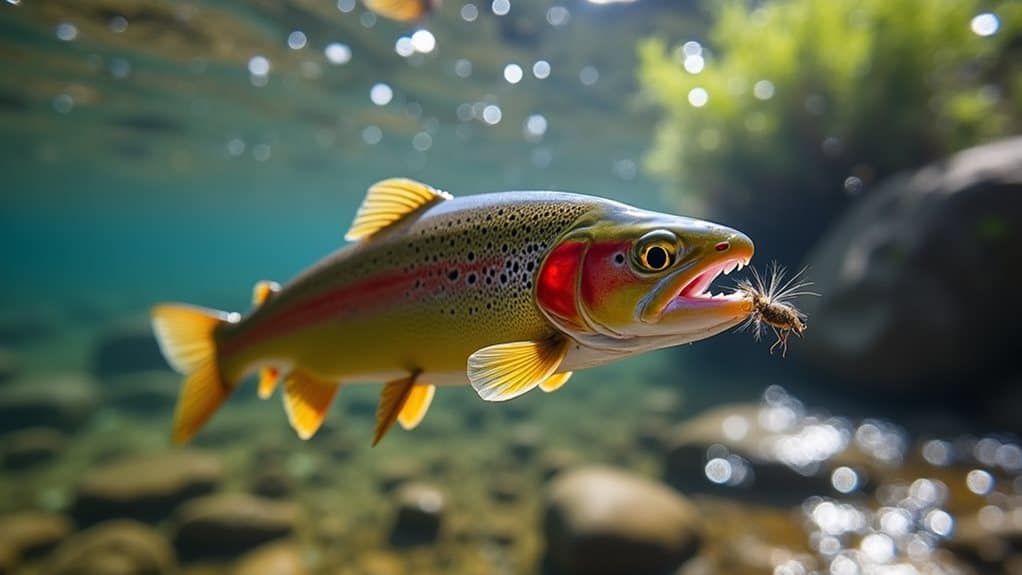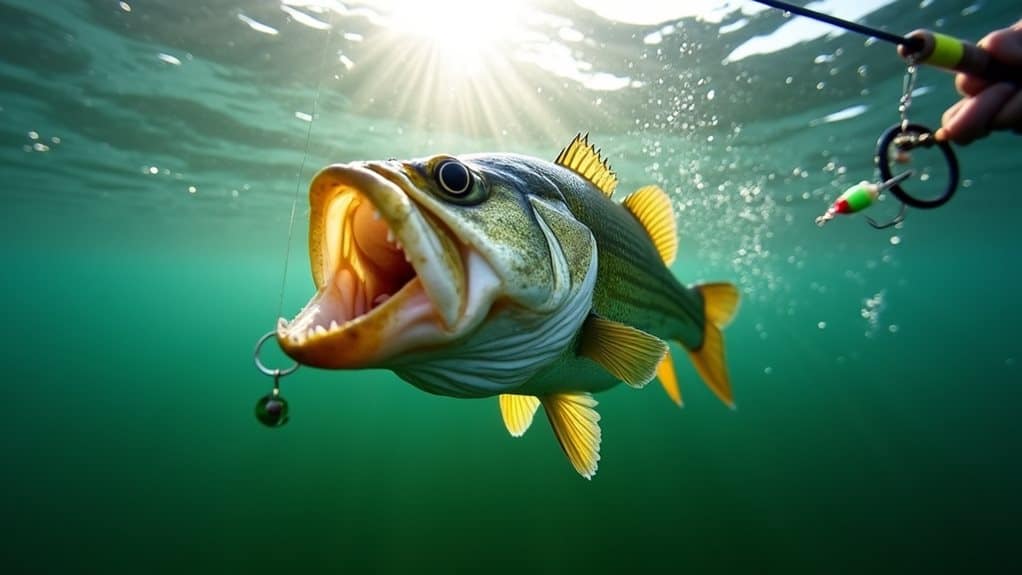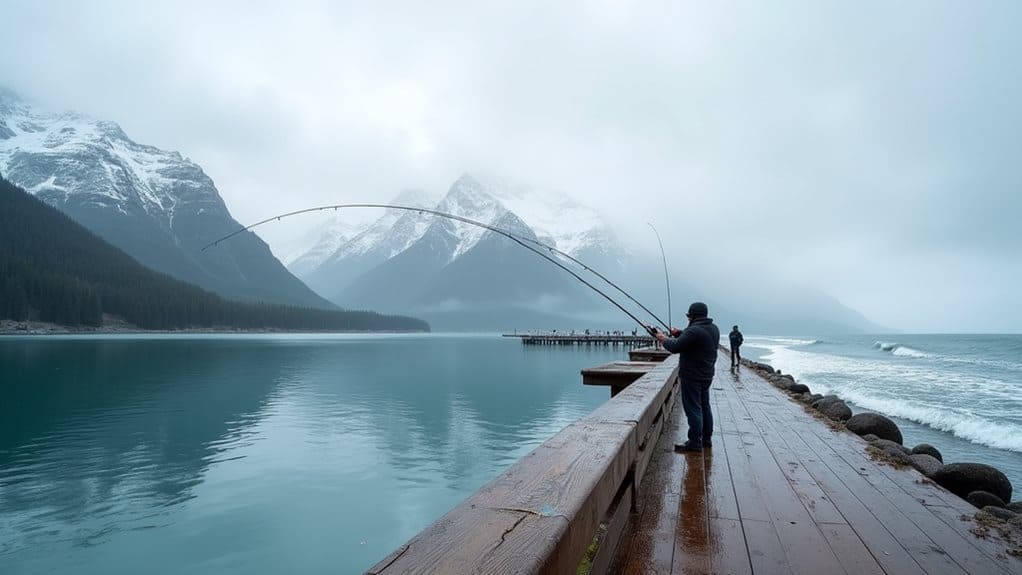The time it takes to catch a fish varies dramatically from minutes to several hours, depending on your environment, target species, and technique. Coastal waters typically offer moderate wait times, while deep-sea fishing requires more patience due to depth and specialized gear. Active casting methods outperform passive approaches, and matching your schedule to species’ feeding patterns—like dawn and dusk for many fish—significantly improves success rates. Understanding these factors will help you optimize your fishing strategy.
TLDR
- Fish catching time varies by environment, with coastal waters offering moderate waits and deep-sea fishing requiring longer periods.
- Environmental factors like water clarity, temperature, and weather patterns significantly influence how quickly fish bite and feeding activity levels.
- Different fish species have distinct feeding patterns, with some active during dawn/dusk while others prefer midday or nighttime.
- Spring and fall seasons typically provide faster catches due to increased fish activity and favorable weather conditions.
- Active fishing techniques like casting, chumming, and targeting underwater structures reduce wait times compared to passive methods.
Average Wait Times Across Different Fishing Environments

When you’re planning a fishing trip, understanding that wait times vary dramatically across different environments can help you set realistic expectations and choose the right location for your skill level and patience.
Coastal waters offer moderate waits influenced by fish behavior and seasonal patterns, especially during the spawning season when needlefish are more active.
Deep-sea fishing typically requires longer waits due to depth and specialized gear requirements. Modern fishing vessels now utilize real-time monitoring systems that track location, speed, and heading to optimize their operations and reduce unnecessary waiting time.
Environmental Factors That Impact Catch Duration
You’ll find that environmental conditions play an essential role in determining how long you’ll wait before landing your next fish.
Water clarity directly affects fish behavior and your ability to present bait effectively, while clearer waters often require more finesse and can make fish more cautious of your approach. In colder conditions, fish may prefer smaller baits that mimic their lethargic state.
Weather patterns, including temperature fluctuations, barometric pressure changes, and wind conditions, greatly influence fish activity levels and feeding patterns throughout the day. Studies of commercial fishing operations show that sea surface temperature, dissolved oxygen levels, and chlorophyll concentrations are among the most critical environmental variables that significantly impact fishing success rates. Additionally, fishing during optimal times, such as dawn or midday, can enhance your chances of success.
Water Clarity Effects
Visibility beneath the surface plays an essential role in determining how quickly you’ll land your next catch, as water clarity directly influences fish behavior, feeding patterns, and your angling success.
Clear water makes fish more cautious and likely to detect your gear, while murky conditions reduce their wariness but may require different techniques and brighter lures.
Weather Pattern Influence
Weather patterns serve as one of the most crucial factors determining how long you’ll wait between casts and catches, with atmospheric changes directly influencing fish behavior in ways that can either accelerate or drastically extend your time on the water.
Falling barometric pressure before storms typically shortens catch times, while post-storm high pressure extends waiting periods considerably.
Fish Species and Their Feeding Patterns

Understanding fish species and their feeding patterns will greatly improve your success rate and reduce the time you spend waiting for a bite.
Different species exhibit varying activity levels throughout the day, with some fish actively feeding during dawn and dusk hours while others prefer midday or nighttime feeding sessions.
You’ll catch fish more efficiently when you match your fishing schedule to these natural feeding time patterns, as hungry fish are more likely to strike your bait or lure. Additionally, recognizing current seams in the water can help you identify prime feeding zones where fish are more likely to gather.
Species Activity Levels
Different fish species exhibit remarkably varied activity levels that directly influence when and how they feed, making some considerably easier to catch than others.
Active species like salmonids constantly move and investigate, creating frequent feeding opportunities and higher catch rates.
Less active flatfish conserve energy with minimal movement, requiring patience and strategic bait placement for successful angling.
Feeding Time Patterns
While each fish species exhibits its own unique activity patterns, their feeding behaviors follow predictable temporal rhythms that can greatly impact your angling success.
Most fish show increased feeding during spring and summer when warmer temperatures enhance their metabolism.
You’ll find peak activity during dawn and dusk shifts, though some species feed continuously throughout the day.
Seasonal and Weather-Related Variations in Fishing Success
As seasons shift throughout the year, your fishing success will fluctuate dramatically based on natural patterns that dictate fish behavior and activity levels.
Spring and fall represent prime fishing seasons, with fish becoming more active as temperatures change.
Weather conditions like atmospheric pressure, storms, and water temperature directly influence fish metabolism and feeding patterns, affecting your catch rates considerably. Additionally, purchasing a fishing license supports conservation efforts, which can enhance habitat restoration and provide more fishing opportunities in the long run.
Fishing Techniques That Reduce Wait Times

Understanding seasonal patterns and weather impacts gives you the foundation for timing your fishing trips, but implementing the right techniques can dramatically cut down your actual wait time on the water.
Active methods like casting outperform passive approaches, while chumming concentrates fish in your area.
Choose lures that match natural prey, and focus your efforts near underwater structures where 70% of catches occur.
Time of Day and Optimal Fishing Windows
When should you actually cast your line for the best chance of success?
Studies show peak catch rates occur between 10 a.m. and 5 p.m., challenging the traditional dawn-and-dusk wisdom.
Fish increase feeding activity during midday hours, especially under overcast skies when they move closer to the surface.
Modern fishing apps can pinpoint hourly feeding windows for maximum success.
Regional Differences in Catch Rates and Wait Times

Where you drop your line makes a dramatic difference in how long you’ll wait for that first bite.
Regional catch rates vary dramatically, with Vancouver Island anglers averaging one fish per day while Lower Mainland streams drop to just 0.28 fish daily.
Fish populations, hatchery rates, and angler pressure create these regional disparities, directly impacting your waiting time.
Final Note
You’ll find that catching a fish typically takes anywhere from 15 minutes to several hours, depending on numerous variables you can control and optimize. By choosing the right location, timing your trip during peak feeding periods, using appropriate techniques for your target species, and adapting to seasonal patterns, you’ll considerably reduce your wait times. Remember, successful fishing isn’t just about patience—it’s about making informed decisions that stack the odds in your favor.




